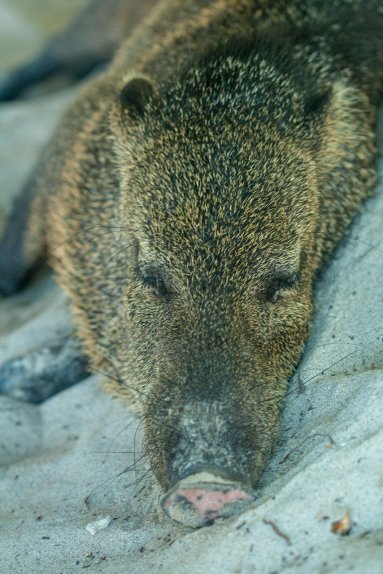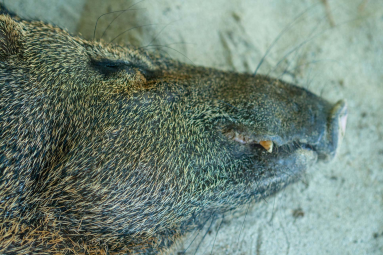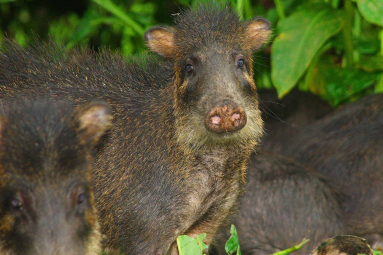Collared Peccaries
Highlights
- Scientific Name: Tayassu tajacu
- Status in the Wild: Common
- Habitat: Cloud Forests, Rainforests, Tropical Dry Forests, Woodlands
- Diet: Omnivore
Collared peccaries are also known as javelinas, thanks to their long, pointed tusks that resemble javelins. Another pseudonym is musk hog, as they frequently rub their oil glands against rocks and tree trunks to mark and defend territory. Their musky odor is always evident, and people often smell a peccary long before they see it. They are much more common than the white-lipped peccary, Costa Rica’s other peccary species. Though pig-like in appearance and behavior, the peccary is not classified in the pig family. Rather, they are members of the Tayassuidae Family, while true pigs are part of the Suidae Family.
read more closeA short, pig-like snout, sturdy hooves and slender tusks characterize the species. On average, collared peccaries measure 35 inches long and tip the scales at 40 to 50 pounds. Their coat is comprised of wiry, dark gray fur interspersed with beige or light gray flecks. True to their name, collared peccaries feature a light beige ring, resembling a collar, around the neck.
Peccaries are mostly vegetarian, dining on seeds, tubers, fruits, roots and leaves. Occasionally, they supplement their diet with small vertebrates or insects and worms. In Costa Rica, scientists have found that the collared peccary diet varies greatly throughout the year. At the beginning of the dry season, they consume mostly roots and tubers, but by February they feast almost exclusively on guacimo fruits. Interestingly, collared peccaries in Costa Rica are known to eat dumb cane, a philodendron that contains high quantities of toxins and is consumed by almost no other animal.
Habitat:
Collared peccaries range from Arizona and Texas down through Central and South America, reaching as far south as northern Argentina. In Costa Rica, this species is very common throughout the country. They are widespread in Puerto Viejo de Sarapiqui, Palo Verde National Park, and Corcovado National Park.
Collared peccaries inhabit dense forest and second-growth jungle, and prefer areas close to a water source. They travel in herds of up to 30 individuals, and their home ranges are estimated at almost 300 acres. The species is very territorial, so herd ranges rarely overlap.
Reproduction:
The gestational period is just under five months, and females give birth to one to five babies, with two being the norm. Collared peccaries are born with either chestnut or beige coloring, and are able to run within hours of birth. In the event of a stampede, the very young sit motionless and wait until the area is safe again to call back their mothers.
Young peccaries nurse for six to eight weeks, and are completely independent by three months. As juveniles, they usually attach to an adult in the herd, which isn’t always the birth mother. Females reach sexual maturity by one year old. Experts believe that wild collared peccaries can live up to 16 years, but few will make it past their eighth birthday.
Status in the Wild:
Collared peccaries are not endangered, but they are sometimes hunted for their meat and hides. Natural predators include coyotes, pumas, jaguars and bobcats. In some areas, they are considered crop predators, as they feast on rice, corn, tubers and melons.
Collared Peccaries in Pictures
-

Collared Peccary Sleeping Tortuga Island - Costa Rica
-

Collared Peccary Sleeping Face Close Up Tortuga Island - Costa Rica
-

peccaries corcovado national park - Costa Rica

